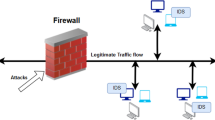Abstract
The most fascinating task in the present world for the creation of online applications is network security. Additionally, since the number of cyberattacks on the internet has risen, new ways for more effective attack identification and avoidance must be established. This may be accomplished by suggesting fresh intrusion methods for identification. IDSs that use machine learning techniques are precise and successful in identifying networks assaults. The presence of redundant or unimportant characteristics in a big dataset may substantially decrease the effectiveness of machine learning models, leading to a sharp decline in quality. Thus, it is imperative to come up with a suitable feature removal technique which will cut down a few of the characteristics that do not have an important effect on the technique of classification. Additionally, when the models are trained on extremely unbalanced datasets, a lot of ML-based IDSs experience a rise in error rates as well as poor detection rate. In this article, we offer a study employing the DTOHE technique along with multiple feature selection methods, including GA, ACO, and PSO. We focused on binary classification configurations in our experiments, and the outcomes showed that the DTOHE with PSO feature selection approach elevated the evaluation precision for the binary categorization scheme from 88.13 to 90.85%.


Similar content being viewed by others
Data Availability
The dataset produced and analyzed in this study can be obtained from the corresponding author upon request, subject to reasonable conditions.
References
Wang Z. Deep learning-based intrusion detection with adversaries. IEEE Access. 2018;6:38367–84.
Tama BA, Comuzzi M, Rhee KH. Tse-ids: a two-stage classifier ensemble for intelligent anomaly-based intrusion detection system. IEEE Access. 2019;7:94497–507. https://doi.org/10.1109/ACCESS.2019.2928048.
Hussen N, Elghamrawy SM, Salem M, El-Desouky AI. A fully streaming big data framework for cyber security based on optimized deep learning algorithm. IEEE Access. 2023;11:65675–88. https://doi.org/10.1109/ACCESS.2023.3281893.
Pham TH, Raahemi B. Bio-inspired feature selection algorithms with their applications: a systematic literature review. IEEE Access. 2023;11:43733–58. https://doi.org/10.1109/ACCESS.2023.3272556.
Kalakoti R, Nõmm S, Bahsi H. In-depth feature selection for the statistical machine learning-based botnet detection in IoT networks. IEEE Access. 2022;10:94518–35. https://doi.org/10.1109/ACCESS.2022.3204001.
Saleh HM, Marouane H, Fakhfakh A. Stochastic gradient descent intrusions detection for wireless sensor network attack detection system using machine learning. IEEE Access. 2024;12:3825–36. https://doi.org/10.1109/ACCESS.2023.3349248.
Karimi Z, Torabi Z. Enhancing kNN-based intrusion detection with differential evolution with auto-enhanced population diversity. In: 2023 14th international conference on information and knowledge technology (IKT), Isfahan, Islamic Republic of Iran; 2023. p. 129–135. https://doi.org/10.1109/IKT62039.2023.10433038.
Preethi P, Vasudevan I, Saravanan S, Krishna Prakash R, Devendhiran A. Leveraging network vulnerability detection using improved import vector machine and Cuckoo search based Grey Wolf Optimizer. 2023 1st international conference on optimization techniques for learning (ICOTL), Bengaluru, India; 2023. p. 1–7. https://doi.org/10.1109/ICOTL59758.2023.10435119.
Dasari S, Kaluri R. An effective classification of DDoS attacks in a distributed network by adopting hierarchical machine learning and hyperparameters optimization techniques. IEEE Access. 2024;12:10834–45. https://doi.org/10.1109/ACCESS.2024.3352281.
Ben Said R, Sabir Z, Askerzade I. CNN-BiLSTM: a hybrid deep learning approach for network intrusion detection system in software-defined networking with hybrid feature selection. IEEE Access. 2023;11:138732–47. https://doi.org/10.1109/ACCESS.2023.3340142.
Wei N, Zheng L, Chen Y, Zhu R, Ren S, Zhang X. Fuzzy logic intelligent space routing convolutional decision and optimization scheme. IEEE Access. 2023;11:139509–20. https://doi.org/10.1109/ACCESS.2023.3338858.
Noori MS, Sahbudin RKZ, Sali A, Hashim F. Feature drift aware for intrusion detection system using developed variable length particle swarm optimization in data stream. IEEE Access. 2023;11:128596–617. https://doi.org/10.1109/ACCESS.2023.3333000.
Alajmi M, Mengash HA, Alqahtani H, Aljameel SS, Hamza MA, Salama AS. Automated threat detection using flamingo search algorithm with optimal deep learning on cyber-physical system environment. IEEE Access. 2023;11:127669–78. https://doi.org/10.1109/ACCESS.2023.3332213.
Rabash AJ, Nazri MZA, Shapii A, Hasan MK. Non-dominated sorting genetic algorithm-based dynamic feature selection for intrusion detection system. IEEE Access. 2023;11:125080–93. https://doi.org/10.1109/ACCESS.2023.3328395.
Almuqren L, Alqahtani H, Aljameel SS, Salama AS, Yaseen I, Alneil AA. Hybrid metaheuristics with machine learning based botnet detection in cloud assisted internet of things environment. IEEE Access. 2023;11:115668–76. https://doi.org/10.1109/ACCESS.2023.3322369.
Bakro M, et al. Building a cloud-IDS by hybrid bio-inspired feature selection algorithms along with random forest model. IEEE Access. 2024;12:8846–74. https://doi.org/10.1109/ACCESS.2024.3353055.
Shanbhag A, Vincent S, Gowda SBB, Kumar OP, Francis SAJ. Leveraging metaheuristics for feature selection with machine learning classification for malicious packet detection in computer networks. IEEE Access. 2024;12:21745–64. https://doi.org/10.1109/ACCESS.2024.3362246.
Tripathi G, Singh VK, Sharma V, Vinodbhai MV. Weighted feature selection for machine learning based accurate intrusion detection in communication networks. IEEE Access. 2024;12:20973–82. https://doi.org/10.1109/ACCESS.2024.3362794.
Maci A, Tamma N, Coscia A. Deep Reinforcement Learning-based Malicious URL Detection with Feature Selection. 2024 IEEE 3rd International Conference on AI in Cybersecurity (ICAIC), Houston, TX, USA; 2024. p. 1–7. https://doi.org/10.1109/ICAIC60265.2024.10433827.
Fuhnwi GS, Revelle M, Izurieta C. Improving network intrusion detection performance : an empirical evaluation using extreme gradient boosting (XGBoost) with recursive feature elimination. 2024 IEEE 3rd international conference on AI in cybersecurity (ICAIC), Houston, TX, USA; 2024. p. 1–8. https://doi.org/10.1109/ICAIC60265.2024.10433805.
Acknowledgements
The authors acknowledged the Quaid-E-Millath Government College for Women (Autonomous), Chennai, Tamilnadu, India for supporting the research work by providing the facilities.
Funding
No funding received for this research.
Author information
Authors and Affiliations
Contributions
This research work owes its realization to the collaborative efforts of all authors, whose collective contributions played a pivotal role in shaping its outcomes significantly.
Corresponding author
Ethics declarations
Conflict of interest
No conflict of interest.
Additional information
Publisher's Note
Springer Nature remains neutral with regard to jurisdictional claims in published maps and institutional affiliations.
This article is part of the topical collection “Advances in Computational Approaches for Image Processing, Wireless Networks, Cloud Applications and Network Security” guest edited by P. Raviraj, Maode Ma and Roopashree H R.
Rights and permissions
Springer Nature or its licensor (e.g. a society or other partner) holds exclusive rights to this article under a publishing agreement with the author(s) or other rightsholder(s); author self-archiving of the accepted manuscript version of this article is solely governed by the terms of such publishing agreement and applicable law.
About this article
Cite this article
Samraj, J., Abirami, K. Attack Detection with Optimal PSO Feature Selection with DTOHE Model. SN COMPUT. SCI. 5, 562 (2024). https://doi.org/10.1007/s42979-024-02911-4
Received:
Accepted:
Published:
DOI: https://doi.org/10.1007/s42979-024-02911-4




